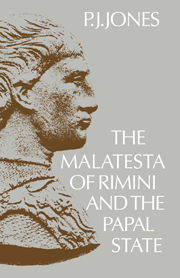Book contents
- Frontmatter
- Contents
- Dedication
- Preface
- Abbreviations
- Map of Romagna and the Marche in the later Middle Ages
- 1 The Papal State and Romagna in the thirteenth century
- 2 Rimini and the rise of the Malatesta
- 3 From commune to papal vicariate
- 4 Galeotto Malatesta, ‘ecclesie pugil’
- 5 The prime of Malatesta rule: Carlo Malatesta
- 6 The pontificate of Martin V
- 7 Sigismondo Pandolfo Malatesta, ‘fex Italiae’
- 8 The papal reconquest
- 9 The government of the Malatesta: I. The papal vicariate
- 10 The government of the Malatesta: II. The signoria
- Appendix
- Bibliography
- Index
5 - The prime of Malatesta rule: Carlo Malatesta
Published online by Cambridge University Press: 23 December 2009
- Frontmatter
- Contents
- Dedication
- Preface
- Abbreviations
- Map of Romagna and the Marche in the later Middle Ages
- 1 The Papal State and Romagna in the thirteenth century
- 2 Rimini and the rise of the Malatesta
- 3 From commune to papal vicariate
- 4 Galeotto Malatesta, ‘ecclesie pugil’
- 5 The prime of Malatesta rule: Carlo Malatesta
- 6 The pontificate of Martin V
- 7 Sigismondo Pandolfo Malatesta, ‘fex Italiae’
- 8 The papal reconquest
- 9 The government of the Malatesta: I. The papal vicariate
- 10 The government of the Malatesta: II. The signoria
- Appendix
- Bibliography
- Index
Summary
It was after Galeotto's death, and during the Great Schism, that the Malatesta of Rimini attained their greatest prominence, if not their greatest power, in the Papal State and in the politics of Upper Italy. While throughout the period they were never without the firm support of the papacy, the gradual emergence now in Italy of a few great territorial states, with regional or wider, Italian ambitions, compelled them also, with other minor despots who had thriven unmolested for a century or more, to look beyond their parochial alliances and feuds and take sides in a larger, general contest. This was the last age of the small signore, adventurer and condottiere. The expansion of the Visconti in the early fourteenth century had revealed the threat to lords of second rank, who could now expect to prosper, or even survive, only as clients or allies of a greater power. With other signori of their kind, the Malatesta, of Rimini and Pesaro, were caught up and forced to participate in a struggle for dominion that began at this time to divide all Lombardy, Tuscany and Romagna, and nearly the whole of Italy. But first of all they have to be seen in their local relations, with the Roman papacy and with the neighbouring lordships of their region.
Galeotto Malatesta left four sons to succeed him, each of whom, for administrative purposes at least, assumed particular control of part of the Malatesta vicariate.
- Type
- Chapter
- Information
- The Malatesta of Rimini and the Papal State , pp. 102 - 148Publisher: Cambridge University PressPrint publication year: 1974



